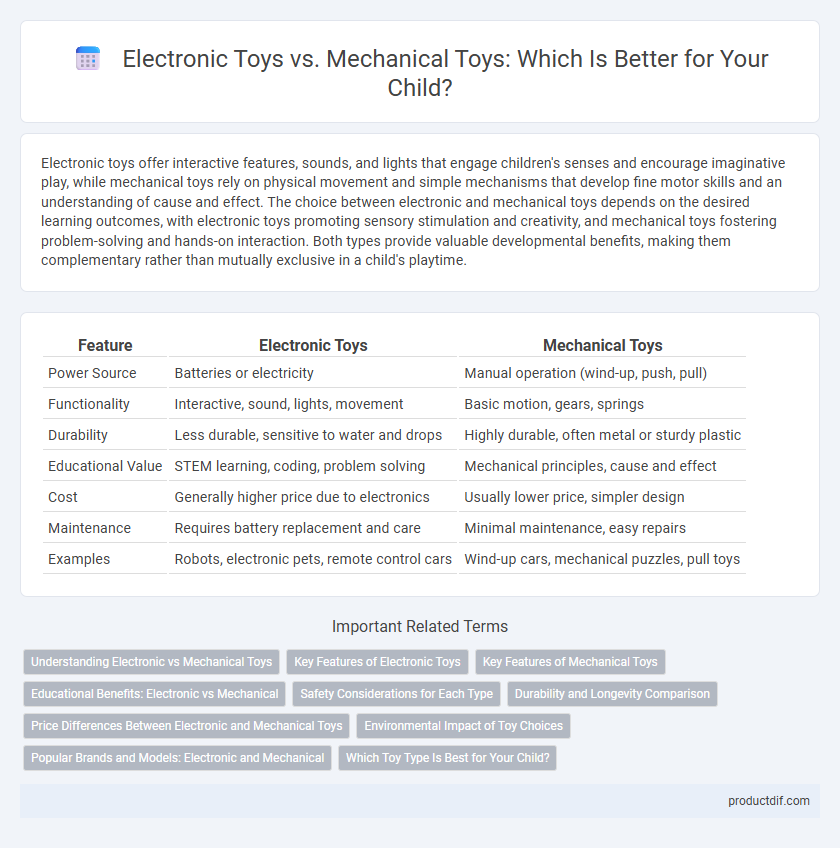Electronic toys offer interactive features, sounds, and lights that engage children's senses and encourage imaginative play, while mechanical toys rely on physical movement and simple mechanisms that develop fine motor skills and an understanding of cause and effect. The choice between electronic and mechanical toys depends on the desired learning outcomes, with electronic toys promoting sensory stimulation and creativity, and mechanical toys fostering problem-solving and hands-on interaction. Both types provide valuable developmental benefits, making them complementary rather than mutually exclusive in a child's playtime.
Table of Comparison
| Feature | Electronic Toys | Mechanical Toys |
|---|---|---|
| Power Source | Batteries or electricity | Manual operation (wind-up, push, pull) |
| Functionality | Interactive, sound, lights, movement | Basic motion, gears, springs |
| Durability | Less durable, sensitive to water and drops | Highly durable, often metal or sturdy plastic |
| Educational Value | STEM learning, coding, problem solving | Mechanical principles, cause and effect |
| Cost | Generally higher price due to electronics | Usually lower price, simpler design |
| Maintenance | Requires battery replacement and care | Minimal maintenance, easy repairs |
| Examples | Robots, electronic pets, remote control cars | Wind-up cars, mechanical puzzles, pull toys |
Understanding Electronic vs Mechanical Toys
Electronic toys incorporate microchips and batteries to offer interactive features such as sounds, lights, and motion, enhancing sensory engagement for children. Mechanical toys rely on physical mechanisms like gears, springs, and levers, promoting tactile learning and motor skills development. Understanding the differences between electronic and mechanical toys helps parents select age-appropriate, educational play options that suit developmental needs.
Key Features of Electronic Toys
Electronic toys feature advanced technologies such as interactive sensors, sound effects, and programmable functions that enhance user engagement. They often incorporate LCD screens, voice recognition, and connectivity options for software updates or remote control. These key features provide dynamic play experiences and educational benefits beyond traditional mechanical toys.
Key Features of Mechanical Toys
Mechanical toys feature intricate gears and springs that enable movement without batteries, offering hands-on interaction and durability. These toys often provide educational value by demonstrating basic principles of physics and engineering. Their tactile design enhances sensory development and encourages imaginative play through physical manipulation.
Educational Benefits: Electronic vs Mechanical
Electronic toys enhance learning through interactive features like sounds, lights, and programmable functions that develop STEM skills and improve cognitive abilities. Mechanical toys foster hands-on problem-solving, fine motor skills, and creativity by encouraging children to manipulate physical components and understand mechanical principles. Both types offer unique educational benefits, with electronic toys providing digital literacy and mechanical toys promoting tactile learning and spatial reasoning.
Safety Considerations for Each Type
Electronic toys often include batteries and small components that pose choking and electrical hazards, requiring strict adherence to safety standards such as ASTM F963. Mechanical toys, while generally simpler, carry risks of pinching or sharp edges, making durable materials and smooth finishes essential for child-safe designs. Parents should evaluate certifications and age recommendations to ensure appropriate safety measures for each toy type.
Durability and Longevity Comparison
Electronic toys often have complex circuits and batteries that can degrade over time, reducing their durability compared to mechanical toys, which rely on simple, robust components like gears and springs. Mechanical toys generally exhibit greater longevity due to fewer electronic parts prone to malfunction, allowing them to withstand rough play and environmental factors more effectively. The ease of repair and replacement of mechanical parts further enhances their lifespan, whereas electronic toys may require specialized skills or parts that are harder to source.
Price Differences Between Electronic and Mechanical Toys
Electronic toys typically have higher price points than mechanical toys due to advanced components like microchips, sensors, and batteries that increase production costs. Mechanical toys rely on simpler materials and manual mechanisms, making them more affordable and accessible to a wider range of consumers. The price gap between electronic and mechanical toys can vary significantly depending on brand, features, and technology integration.
Environmental Impact of Toy Choices
Electronic toys consume batteries and often involve non-recyclable components, contributing to e-waste and environmental pollution. Mechanical toys, generally made from durable materials like wood or metal, tend to have a longer lifespan and are easier to recycle or repurpose. Choosing mechanical toys reduces carbon footprint and minimizes hazardous waste compared to electronic counterparts.
Popular Brands and Models: Electronic and Mechanical
Popular electronic toy brands include Hasbro's Nerf Laser Ops and VTech's Kidizoom Camera, featuring interactive lights and sounds that engage children in innovative play. Mechanical toy favorites like LEGO and Playmobil offer timeless appeal with intricate, hands-on building sets that stimulate creativity and fine motor skills. Both categories showcase standout models, such as Anki's Cozmo robot for electronic toys and Meccano's classic construction sets for mechanical toys, blending entertainment with educational value.
Which Toy Type Is Best for Your Child?
Electronic toys offer interactive features and educational content that can enhance cognitive development and keep children engaged longer. Mechanical toys, on the other hand, encourage hands-on creativity, fine motor skills, and problem-solving through tactile play. Choosing the best toy type depends on your child's interests and developmental needs, balancing screen time with physical activity for optimal growth.
Electronic toys vs mechanical toys Infographic

 productdif.com
productdif.com